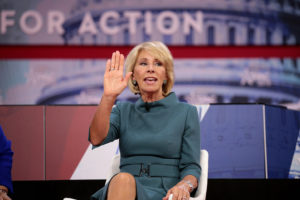Hey, Betsy, Leave Them Kids Alone
 Education Secretary Betsy DeVos (photo by Gage Skidmore)
Education Secretary Betsy DeVos (photo by Gage Skidmore) If you’re an avid Simpsons fan like me, you’ll recall the time Ned Flanders, the religious “neighboroni” to the Simpson family, becomes the principal of the elementary school. Flanders leads the school in a simple prayer: “Let us thank the lord.”
Upon hearing the fledgling prayer, Superintendent Chalmers, the hard-to-please school system administrator, erupts in a small uproar. “A prayer?” he yells. “A prayer in a public school? Prayer doesn’t belong in a public school just like facts don’t have a place within organized religion.”
There’s something fundamental to take away from Chalmers’s words, beyond his aggravated tone. Our schools are one of the most common battlegrounds for the separation of church and state. The guidelines put out last week by President Trump and Secretary of Education Betsy Devos regarding a student’s right and ability to pray in school open a new front in that battle over church-state separation.
The clearest change proposed last Thursday in the Oval Office was to an executive order from the Obama administration that compelled religious organizations to inform the people they serve if there are secular providers from whom they can receive the same service. That can benefit social service organizations that seek to proselytize to those receiving their help. Such groups could also refuse services, say not providing medical care to an LGBTQ individual who needed critical assistance, and thanks to Trump, the religious organization does not need to point the vulnerable non-patient in the direction of a secular provider who can help.
Beyond that, the guidelines for school prayer don’t outline a new policy or do much of anything new.
So why did they bother publicizing them? Clearly, they intend to codify sectarian expression in public school—in a way beyond current permissible expression.
Devos recently penned an opinion piece in USA Today to outline the way these guidelines will protect students’ “first freedoms.” In it she claims that “the notion” of separation of church and state is not an invitation for government to separate people from their faith.
Looking closely at the cherry-picked examples DeVos offers, it’s important to read between the lines to spot the manufactured victimization of Christian students.
There’s the Utah elementary school student who wore ashes on his forehead to class on Ash Wednesday and was incorrectly told to wash it off. DeVos paints the story s if the child was bullied out of expressing his faith, which was not the case. It was a misunderstanding and the teacher later apologized.
She also cites Kentucky teachers who were involved in setting up a “prayer locker” that should not have existed in the first place. It was a misuse of school time and property, but because it involved what she saw as a group of victimized Christians, DeVos declared it an injustice.
In the case of the football coach in Washington State praying to God with his football players, the coach acted out of line by promoting faith in his official school role and was terminated by the school district. DeVos claimed he was terminated for his faith, again twisting the truth.
Of course, this kind of argumentation is nothing new. The guidelines are merely an extension of the religious right’s ongoing attempts to usher in policy changes wherever they can. To name a few:
In Indiana, there’s a renewed attempt to post “In God We Trust” posters in every classroom. Basically one’s child will not be immune to a reinforcement of a higher power, even in an intended-as-secular space. State Senator Dennis Kruse claims it will serve to remind students of their national motto, which is hardly a pressing issue facing American school children.
There is a separate push in Missouri to regulate books students can check out. Missouri Republican Ben Baker claims it will protect students from checking out sexually explicit material, but who’s to say a commissioner won’t just ban books with LGBTQ themes?
And in Michigan, it’s a tale we’ve heard before, with the governor and the legislature fighting over public funds going to private schools. Not only is this a means for state money to fund religious schools, but it also weakens existing public schools by diverting money away from them and towards sectarian institutions (the church).
Speaking of which, today the Supreme Court is hearing arguments in Espinoza v. Montana Department of Revenue. It has major ramifications on practices on all the above legislation attempts in the future.
DeVos’s expansion of “religious freedom” ultimately serves as a dog whistle to bolster Christian supremacy—and she doesn’t hide it well. Her proclivity toward religious schools, not to mention her previous means to benefit from them, are all part of her zeal to incorporate faith into public spaces.
When I was in fifth grade in Alabama, I attended a school trip held at a lakeside camp. The trip was something I was excited about for months. It wasn’t until I got there and realized it was a religious camp with faith-based programming that my attitude around the three-day sleep-away trip began to sour. There were religious songs and we had to say grace before meals (the food was awful too). With DeVos acting as if students’ right to pray is being subverted in cases where the real problem is teacher or staff involvement in said prayer, I’m disheartened to think that future humanist or nonreligious fifth-graders could encounter something similar.
Superintendent Chalmers, where are you?
